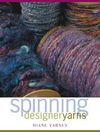 The Essentials of Yarn Design for Handspinners
The Essentials of Yarn Design for Handspinners The Essentials of Yarn Design for Handspinners
The Essentials of Yarn Design for HandspinnersAlthough this book does discuss the basics of spinning, it assumes a general understanding of how to make yarn and goes into detail about options and how to design the yarn you want. It's not for the absolute beginner, but for a spinner who can make reliable yarn and wants more control of the process. It's full of photos, diagrams, charts about fibers, fiber prep and novelty yarn styles. If you want to know about angle of twist, this is the place to look. Some of the fiber detail is outdated, but overall it is a good introduction to the wide range of fibers available, particularly of British sheep breeds.
 Hand Woolcombing and Spinning: a Guide to Worsteds from the Spinning-Wheel
Hand Woolcombing and Spinning: a Guide to Worsteds from the Spinning-WheelIn this book, Peter Teal doesn't hide his opinion that worsted is the highest level of handspinning art, something that many people wouldn't agree with. But his treatment of the subject is considered a classic. From selecting fleeces to making your own wool combs, it's all here. Since this book was published there are many more options available to handspinners. Few people follow the traditional British practice completely and even fewer care to make their own combs. But if you are at all interested in combing or traditional worsteds, read the book and choose what you like to add to your own spinning.
 Spinning Designer Yarns
Spinning Designer YarnsThis survey of novelty yarn techniques has been out a while but is still a good source of ideas for what can be done with fiber other than smooth and even. This book was a big help when I had to come up with ideas for those "special effect" yarns. I still don't like them, but even I was able to come with stuff after looking at these examples.